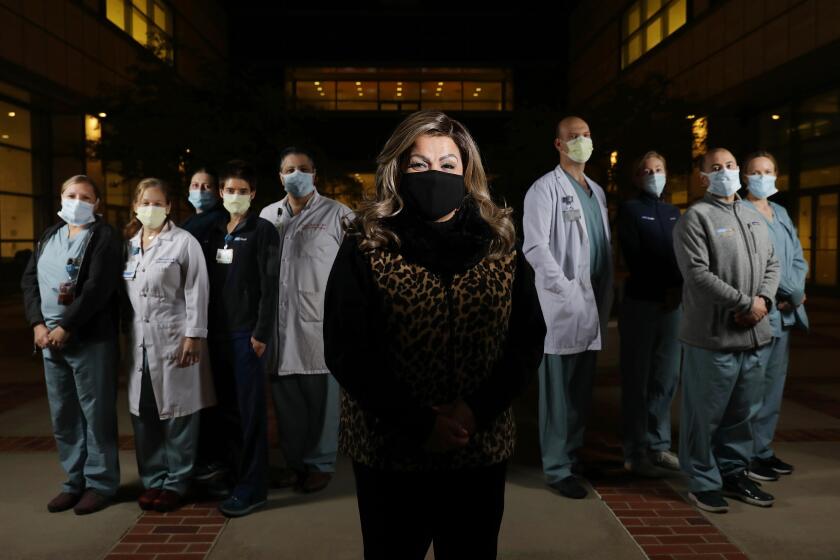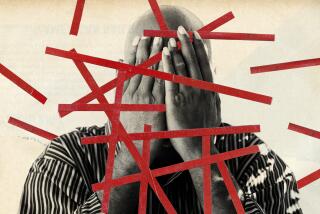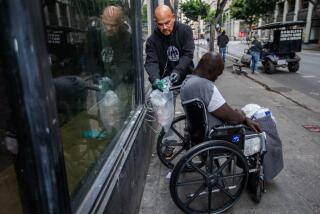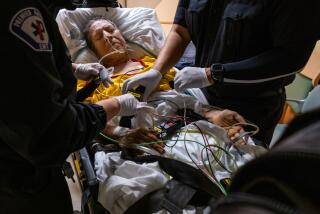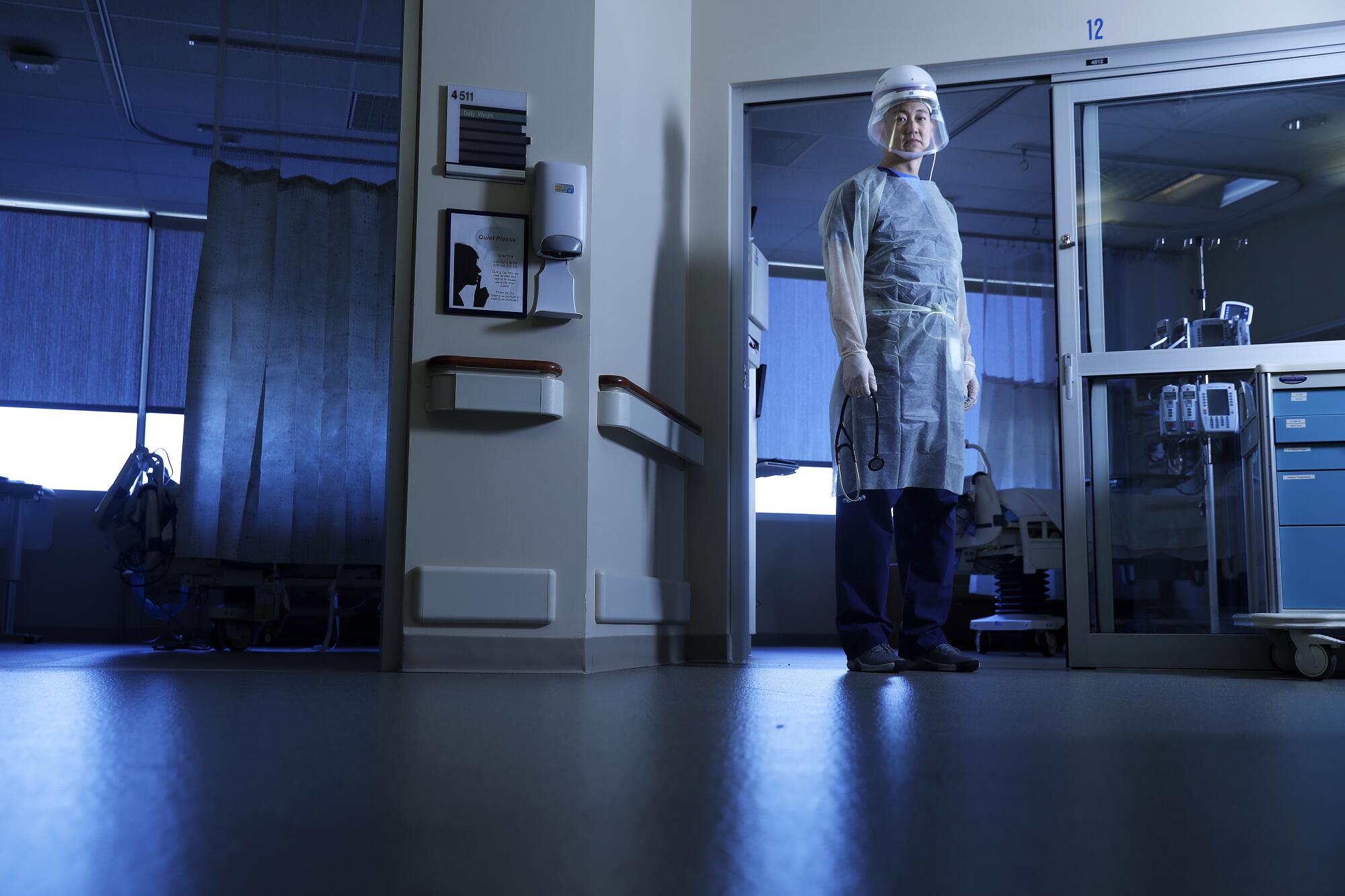
Blanca Lopez was drowning. Her lungs filled with fluid, and a mask over her mouth and nose flooded her with oxygen. She gasped, threw up her arms and yanked it off.
A bedside monitor screamed and grew faint as Lopez, infected with the coronavirus, lost consciousness.
Her heart and brain, deprived of oxygen, weakened. Cells in her blood vessels that maintain pressure began to die. Her kidneys slowed. She felt the room grow dark and quiet.
A nurse rushed in and hit a button on the wall. âCode Blueâ sounded throughout the fifth-floor intensive care unit of Adventist Health Glendale medical center.
Specialists ran to Room 4506. They donned masks and face shields and tried to squeeze air into Lopezâs damaged lungs with a respiratory bag.
Dr. Leo Shum, dressed in a ventilated suit and hood, positioned himself at the head of the bed. He fed a tube down her throat toward the branching of her lungs.
A ventilatorâs steady whoosh brought a familiar calm to the room. Intubated, Lopez lay slightly elevated on her back, sedated and chemically paralyzed.
She had been admitted Aug. 7, and for two weeks, COVID-19 had tightened its coil. She had been given drugs and treatments; she had been rolled onto her stomach. But nothing worked.
Shum had run out of options. He texted a colleague at Ronald Reagan UCLA Medical Center.
Hi Dr. Benharash. This is Leo Shum, one of the intensivists at Glendale Adventist medical center. I was hoping to discuss a COVID patient with you for possible ECMO.
Shum had used a common abbreviation â ECMO â for a medical device that provides extracorporeal membrane oxygenation. Described by some as dialysis for the lungs, ECMO works on the same principle as a heart-lung bypass machine, but patients can stay on ECMO for weeks.
For the sickest of the COVID-19 sick, ECMO has become a final option, and from the start of the pandemic, a team of physicians and nurses at UCLA have employed the device when ventilators are no longer sufficient.
âDoctors have a choice,â said Dr. Vadim Gudzenko, an intensivist at UCLA, âeither turn to ECMO as a Hail Mary or stay the course and see how it goes.â But from his experience, patients on ECMO would have died without ECMO.
The latest maps and charts on the spread of COVID-19 in California.
Of the 39 COVID-19 patients put on ECMO at UCLA, 15 recovered and were discharged, 12 died, eight are still on the machine and four remain in the hospital, Gudzenko said. Infection, organ failure, stroke and profuse bleeding are the causes of mortality.
ECMO is risky. But it was Blanca Lopezâs only hope.
::
Three weeks earlier, Lopez had called Dr. Razmik Ohanjanian, her primary care physician for 25 years. She was congested and had a headache and sore throat.
She and her family lived in two palm-shaded houses next to the 5 Freeway in Glendale. Lopez, 48, shared one home with her mother and father and oldest son. Her mother has Parkinsonâs and dementia, and her father has diabetes and angina. Her oldest son, 25, has developmental delays.
Lopez is separated from her husband, Arturo Juarez, who lives in the other house with their son Criztiaan, 18, and daughter, Arlene, 13. Criztiaan describes himself as mildly autistic, and Arlene was recently diagnosed with dyslexia.
Ohanjanian prescribed an antibiotic and steroid. Lopezâs fever continued, and on Aug. 2, her coronavirus test came back negative.
Lopez was not worried. COVID-19 was no worse than the flu, she believed, its symptoms exaggerated by politicians who used fear of the disease to control people. But her chest was tight, breathing hurt. She thought she was having an asthma attack, the first in nearly five years.
She was tested again, and on Aug. 7, the results came back positive. Ohanjanian told her to go an emergency room. But she didnât want to.
Mexicans who go into the hospital with COVID-19, she said, come out dead, feet first.
::
Waiting inside a tent in the Glendale Adventist parking lot, Lopez clutched a small bag containing clothes, toiletries and a white writing board she bought at Dollar Tree. Talking was already difficult.
She was certain she had gotten sick from her husband, who had gotten sick from her uncle, who had gotten sick from his daughter, who had gotten sick from a woman sneezing without a mask while ordering pizza at Costco.
Sitting by herself, she tried not to be afraid. She had overcome so much in her life: leaving her first husband, getting a job at Costco, rising in membership sales. She had stopped working in 2013 after foot surgery.
She traced her inner strength to childhood when she translated for her parents, who spoke only Spanish. She used to climb on the counter at their bank in Glendale and explain what her mother needed.
The hospital assigned Lopez a bed in a telemetry unit for COVID-19 patients. Two small tubes, partially inserted in her nostrils, provided a steady flow of oxygen.
With each inhale, air coursed into the branches of her lungs and terminated in the alveoli, nearly 500 million air sacs surrounded by capillaries, where an exchange of oxygen and carbon dioxide occurs.
But the virus was choking off the alveoli, one by one, so that Lopez breathed faster and needed a higher concentration of oxygen.
She worried about her family. Who would remind her parents to take their medications or watch what they ate? Who would keep her children on track at school?
Her husband had just tested positive and was in the room next to hers. She imagined social services breaking up their home.
She clutched a white rosary the hospital chaplain had given her. He told her it had been blessed with holy water. âWhen you feel youâre alone, youâre not. God is with you,â he said.
She saw patients wearing oxygen masks and was told to put one on. She tried to suck in as much oxygen as she could, but she was tired and scared, which made her breathing more shallow and fast.
As her oxygen levels continued to fall, a nurse explained the next step: a larger mask. Relax, she said, as she strapped it over Lopezâs nose and mouth. It will breathe for you. Just follow along.
âI canât,â Lopez said. âI canât.â
She panicked and yanked it off. The bedside monitor screamed.
The room grew dark and quiet.
::
At the UCLA medical center, Dr. Peyman Benharash was repairing an aortic aneurysm when Shumâs text came in from Glendale Adventist. An hour later, Benharash called Shum.
They agreed that ECMO could save Lopezâs life, but they wanted to give her a little more time on the ventilator.
By early evening, Lopez had not improved, and Shum worried that running the ventilator on high for too long would permanently damage her lungs.
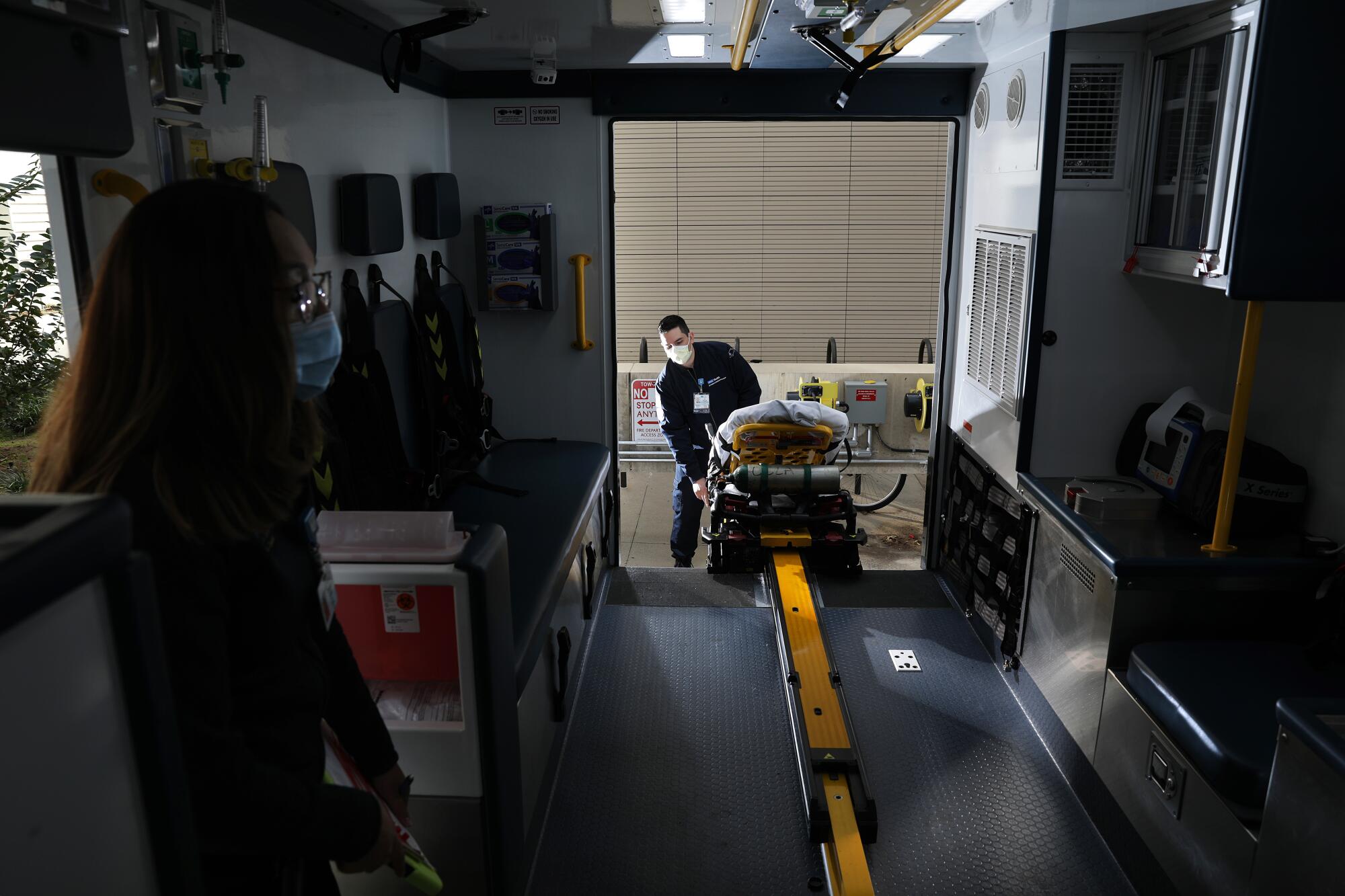
Benharash agreed and notified his team.
âShe needs us,â he said. âWhat time can we leave?â
Two paramedics, a nurse, a respiratory therapist and Stephanie Bland, a specialist in ECMO, met in the ambulance bay. Benharash drove his own car. Two residents joined him.
The ambulance, running with sirens and lights on side streets, coursed through evening traffic and sped along the freeway over the Sepulveda Pass, through the Valley to Glendale.
By the time the team arrived â their gurney piled high with equipment â Benharash was setting up inside a sterile field that the hospital had established in the hallway. He scrubbed in and put on a ventilated hood that smelled of disinfectant. Double gloved and double gowned, he entered Lopezâs room.
Bland followed with the ECMO machine, an odd-looking assemblage of plastic tubes, circuitry, valves and digital display.
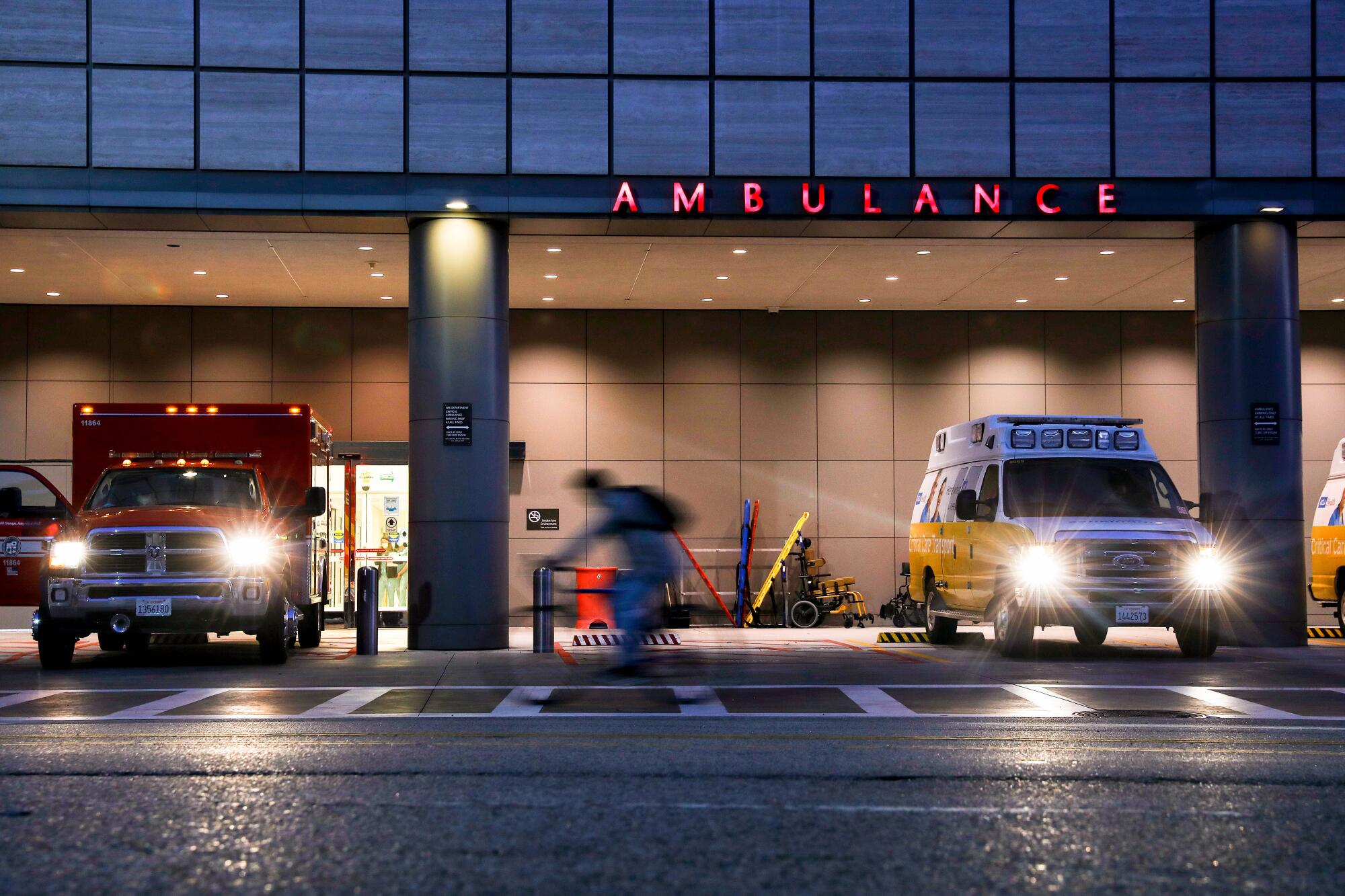
Lopez was unconscious and immobile, slightly angled up in her bed. Her chest rose and fell in rhythm to the ventilator. Medication had begun to thin her blood, making its platelets less viscous and less likely to clot when it entered the machine.
Benharash asked for the bed rails to be lowered and for Lopez to be laid flat. They had two minutes before her oxygen levels would start falling.
He and a resident used ultrasound and a blood draw to find the veins on either side of Lopezâs groin.
Mirroring each other, they made two cuts and inserted a series of tubes that progressively widened the circumference of the blood vessels, which would tear if they were not dilated enough. Blood loss would be catastrophic.
Benharash then took a long tube â a cannula â with the diameter of a Sharpie pen and began pushing it into her right vein, nearly two feet, to the atrium of her heart. Clamped at the opposite end, it filled with blood. The resident worked a shorter cannula into her left side.
Bland handed Benharash two tubes from the ECMO machine and made sure there were no air bubbles in the system.
âOK, weâre ready,â Benharash said. âLetâs go on.â
They removed the clamps, and Bland started the pump inside the ECMO machine.
::
At 7 a.m. the next day, Lopez lay in a medically induced coma. She had been transported the night before to the UCLA medical center, where an ECMO team could attend to her.
Lopezâs nurse, Lindsay Brant, pulled open the blinds to Room 7413 and glanced out at the morning light brightening the neighborhoods west of Gayley Avenue.
Her new patient lay under a white sheet and blanket. Cuffs of soft fabric restrained her wrists. Nearly 10 tubes entered Lopezâs body. Electrodes were attached to her skin.
The lines and catheters arced nearly 10 feet through a sliver of open door into a hallway, where staff assessed patients and administered medications without having to don personal protective equipment and enter the room.
At the foot of her bed stood the ECMO machine. Its monitor faced out. Its pump let out a steady purr.
A series of stitches through the skin secured the cannulas to Lopezâs thighs. Through one cannula, dark red venous blood streamed at a gallon a minute into the machine, where it flowed beside a thin sheet of silicone rubber. Molecules of carbon dioxide and oxygen changed places, just as they do in the alveoli, and the blood flowed back into her body through the other cannula, a brighter and lighter red.
Brant had just started her shift. COVID-19 and the absence of family support had made nursing a more intense relationship of intimacy and trust. But ECMO added another dimension: time.
Once on the machine, patients take weeks to recover, if they recover at all.
::
Lopez needed to be awakened. Her medical team had to know if she had suffered brain damage due to oxygen deprivation.
Rising from the depths of sedation, Lopez responded to requests. She opened her eyes and blinked. She made fists and wiggled her toes. But the virus played havoc inside her. Her vital signs were erratic.
The next day she started to crash. As her heart rate, blood pressure and oxygen level fell, the lines to the cannulas began jumping and jerking about.
Brant had seen it before. Treating COVID-19 requires drying out the lungs. Diuretics are prescribed, but they pull fluids out of the body. Lopez was bleeding at the cannula sites, as well, and would need a transfusion.
With her circulatory system failing, the ECMO machine was choking without enough blood to run through the pump. Brant wanted to discontinue the diuretics but was advised against it.
She instead tried shifting Lopezâs position. Elevating a thigh or angling a hip can direct more blood into the machine.
Brant received instructions to decrease the sedative, which kept her blood pressure low, and to administer a drug that would elevate her blood pressure.
Less sedated, Lopez grew restless. She was still intubated, and Brant knew she could feel the tube in her mouth and throat and a slight push and pull of air in her sticky lungs.
Unaware that the ECMO machine was breathing for her, Lopez gasped, out of rhythm with the ventilator. Her chest heaved. Her body shook, and her oxygen levels fell further.
Brant had to reverse course and restore the sedatives. So they danced, nurse and patient, for days on end.
The virus was not giving up.
::
Lopezâs son Criztiaan had lost hope. He had not seen his mother in weeks.
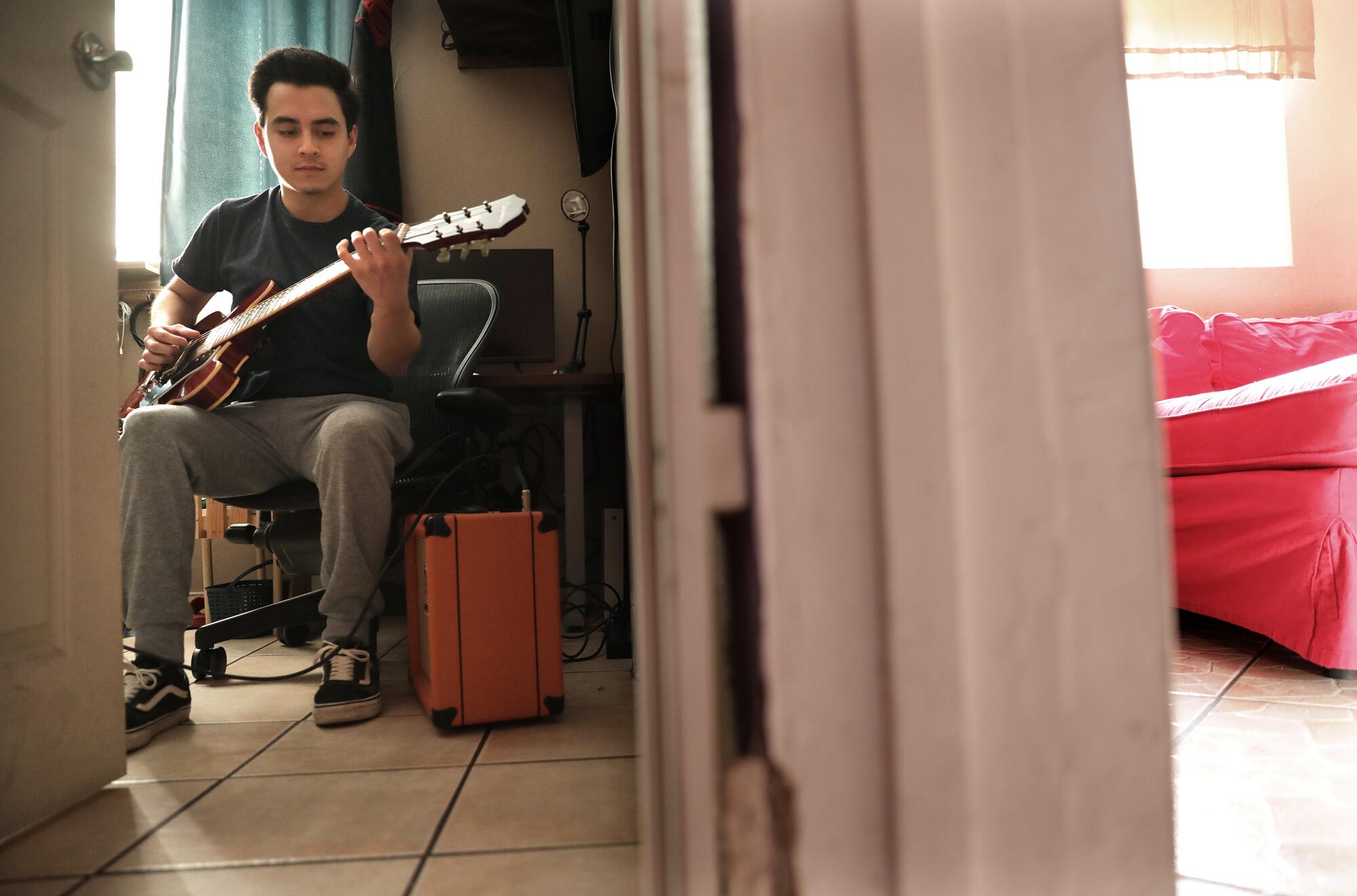
Stepping outside the family home, he listened to traffic on the freeway. He wanted to visit her, but the COVID-19 unit didnât allow visitors. He called, up to three times a day, but it was always the same.
âSheâs stable,â a voice on the other end replied, âbut still no improvement.â
Life at home had changed so much without her. His grandmother was eating less. His grandfather binged on coffee and doughnuts. His brother was living off soda and cup-of-noodle soups.
Criztiaan didnât know what to do. He stopped playing video games. He picked up his guitar and listened to his bands: Metallica, Megadeth, Slipknot. Lost in their worlds of chaos and mayhem, he found his own a little less desperate.
He felt his dreams for the future fade. Surviving and taking care of his family was all there was.
The virus, he believed, had happened because God wanted to humble people for destroying the planet. God wanted to wake them up.
âEven before this happened, I didnât trust the world,â he said. âI donât think I ever will, which is a good thing. It keeps me safe.â
Then, on Sept. 9, the hospital phoned his father, who didnât understand. Criztiaan called back, and the phone rang and rang.
No one picked up.
::
Lopez had stabilized. For days now, her chart read NAEO â no adverse events overnight. The swings of blood pressure and heart rate had moderated. She had a tracheotomy and had stopped fighting the ventilator so much.
The ECMO machine was no longer needed.
When nurse practitioner Susan Valentine started work at 6 a.m. Sept. 9, Lopez was calm. Her oxygen level was good. Valentine sent a text to Benharash.
Good morning, want to go ahead and decannulate (will put sutures in both groins) early if OK with you.
âOK,â he called back. âTake her off.â
Valentine put Lopez into a deep sleep. She and a colleague cut the sutures holding the cannulas in place. They clamped the ends and extracted the tubes from the veins.
For 20 minutes, they pressed their palms against the sites of bleeding, and then, with one stitch on each groin, they closed the wounds.
Blood had soaked the sheets, and Valentine told the nurses to wait on cleaning up for at least two hours. She didnât want to risk jostling Lopez.
By 8 a.m. rounds, Lopez looked better, and for the rest of the morning, Valentine monitored her. The numbers at 11 a.m. were good. Her oxygen and carbon dioxide levels were within limits. Her pH level was stable.
âThis is great,â Valentine told herself. âWe did the right thing.â
But the virus was not through with Lopez. Her lungs absorbed oxygen, but they had stopped offloading carbon dioxide. Her blood, saturated with the gas, became acidic. Cell and enzyme functions were going haywire.
Her muscles burned with lactic acid. Her nostrils flared. Her shoulders rose and fell with her chest.
A nurse paged Valentine, who was shocked by what she found. She ordered a chest X-ray, a scope of Lopezâs lungs and an echocardiogram. A blood test at 3:30 p.m. confirmed the bad news.
The latest maps and charts on the spread of COVID-19 in Los Angeles County, including cases, deaths, closures and restrictions.
The carbon dioxide level in Lopezâs blood was so high it could not be accurately measured. The pH level was falling. Her heart raced, more than two beats a second.
Valentine was not going to lose Lopez. She paged Benharash. He needed to reinsert the cannulas.
The team injected bicarbonate to neutralize the acidity of her blood. They gave medications to boost blood pressure. They stepped up the ventilator. But none of these measures were sustainable.
âWe knew if we didnât get her back on ECMO, she wouldnât live through the night,â Valentine said, âor until her family could get here.â
She phoned Criztiaan. She did not want the only call the family received to be the news that Lopez had died.
âYour mom is not doing well,â she told him.
At 4 p.m., Benharash dashed onto the floor. He pulled on PPE and made a quick assessment. The team had to decide whether trying to save her life was the right course to follow. Had too much internal damage taken place? Were they prolonging a life when it was too late?
Benharash knew that connecting a patient to ECMO a second time seldom resulted in a good outcome, but he also knew that Lopezâs death would jeopardize her family. The team decided to go ahead.
Benharash and a resident inserted new cannulas. The lines were connected, and the team turned on the machine. The pumpâs familiar purring filled the room.
Valentine took a step back and watched the dark red blood turn bright in the machine. As a Christian, she prays each morning for her ECMO patients by name. âPlease,â she asks, âlet them recover if it is Godâs will.â
Then she goes to work, knowing that faith â and Godâs will â may not be enough.
::
Days later, Lopez opened her eyes and wondered where she was. The room was dark. Everything was hazy, and in this strange twilight, she thought of God.
âI know youâre not going to let me go,â she prayed. âI know youâre going to hold on to me.â
She wondered what had become of her white rosary, the one she held when she went into the intensive care unit at Glendale Adventist hospital.
A woman stood nearby. She was beautiful, Lopez thought, and so young. She said she was Lopezâs nurse.
She asked Lopez to lie still, as someone else began lifting a thin plastic film that covered the cannulas. They were changing the dressings.
Lopez tried not to squirm. She felt the wrist restraints and looked around the room. Two plastic tubes, filled with her blood, fed into a machine at the foot of the bed. The nurse said that it was breathing for her.
Lopez started to grow uncomfortable. Her mouth never felt so parched, so raw. What had Criztiaan said? That dying of thirst is worse than dying of hunger.
She remembered the writing board she had packed. She wrote her question, letter perfect and punctuated: Can I please have some water?
But Brant, her nurse that day, said no: Her lungs had to stay as dry as possible. Brant offered a spray, then a small sponge for swabbing the mouth.
Lopez tried to be polite. She tapped her pen on the board. Can I please have some water?
Brant would not allow it, so Lopez pleaded with a doctor, who agreed to an ice chip every hour, and then, every 15 minutes.
When Brant lifted one in a spoon, Lopez frowned. âWhatâs wrong?â Brant asked.
âThat is not a very big chip,â Lopez mouthed.
::
Lopezâs body was healing, but she was traumatized and scared.
Patients, starved of oxygen and revived by ventilators or ECMO, donât trust the machines. Anxious, they hyperventilate, which lowers oxygen and increases distress. Medications donât help either. They inhibit breathing.
Her social worker, Cathy Levenstein, entered the room in PPE and asked Lopez to look at her. âYouâre safe,â Levenstein said. âWeâre taking good care of you.â
In a calm and measured tone, she helped Lopez relax. Focus on whatâs around you, even the television, Levenstein said: Be present and mindful.
But Levenstein knew Lopez needed more. âDo you want your family?â
The hospital made an exception to its one-visitor rule and allowed Criztiaan and his grandmother to see Lopez together. They adjusted their masks and stepped into her room. The blinds were pulled, so there was no way to tell if it was day or night.
âYour family is here,â the nurse said.
Criztiaan thought he saw his mother smile. He encouraged his grandmother to step closer. She held her daughterâs hand. Worried she might knock something over, Criztiaan steadied her.
After five minutes, they changed places. âI love you,â Criztiaan told her. âYouâre going to get through this.â
But looking at the ECMO machine and seeing tubes filled with his motherâs blood, he wondered.
::
No one expected the machine to fail.
But its pump, magnetically levitated, running at 50 revolutions a second, was so delicate a blood clot could jam it.
Late on a Wednesday night, its steady purr turned to a hard metallic staccato like the grinding gears of a car. An internal rotor had seized while the outside pump still spun.
Alarms shrieked. The flow of Lopezâs blood came to a halt.
The hospital kept an auxiliary machine in the hallway, and two members of the medical team rushed it into Lopezâs room. They swapped units, applied clamps, traced lines â red to red, blue to blue â and turned the dial that set the new pump in motion.
Blood started circulating again.
Ten days later, Lopez had a fever. It peaked at 102. Her white blood cell count was up, and once again her blood pressure and oxygen levels were falling. Had she contracted the virus again?
A test revealed a bacterial infection. Sepsis had set in, and if it got into the cannulas, they would have to be changed, or ECMO discontinued. A course of antibiotics was prescribed.
Despite such setbacks, Lopez continued to improve. Her mind grew clearer. She shook off the delirium that patients, besieged with lights, alarms and day-and-night demands, often experience in the unit.
Still connected to ECMO, she started to walk the hallway, 60 feet the first time, accompanied by Brant, another nurse, a physical therapist and a specialist who pushed the machine in front of Lopez.
âIt was kind of shocking to all of us,â Brant recalled. Lopezâs core strength seemed undiminished.
Benharash one day passed her room and saw a patient he didnât recognize. The nurses told him it was Lopez. She had put on her pear-flavored lip gloss.
Later, she let Brant brush her hair. For weeks, it had just been tied up, and Lopez needed help getting out the snarls. She wanted to see herself as she once was, healthy and proud.
But she worried. Criztiaan had called to say that Grandpa was eating only doughnuts and that they didnât have enough money for groceries.
She had gotten a notice that she was behind on her car payment, and she wondered whether Medicare and Medi-Cal would pay for this hospitalization.
She thought about her white rosary. She and Brant had looked through the small bag but couldnât find it.
::
On Oct. 15, Lopez was taken off ECMO for the second time, and when her blood pressure and oxygen levels stabilized, she was transferred to another unit of the hospital.
Gudzenko, the intensivist who had watched Lopezâs progress, got the news from a colleague. Breaking COVID-19 protocols, he raised a hand, and they slapped palms.
âThis constant life-and-death battle makes us analytical and pragmatic,â he would later say. âWe have to be. You cannot die with every patient, but sometimes we do.â
Only now, they had won. They had beaten the worst of the virus.
Six days later, Lopezâs feeding tube was removed. She ordered chicken fettuccine Alfredo, peas and corn, a salad and chocolate cake. She hardly touched it, but she took a picture.
Ohanjanian, her primary care physician, transferred Lopez to Glendale Adventist for rehabilitation. When she arrived at the hospital, he noticed weakness and shaking on her right side. He ordered a CT scan, and it showed an infarction of the left parietal lobe. Lopez had suffered a stroke.
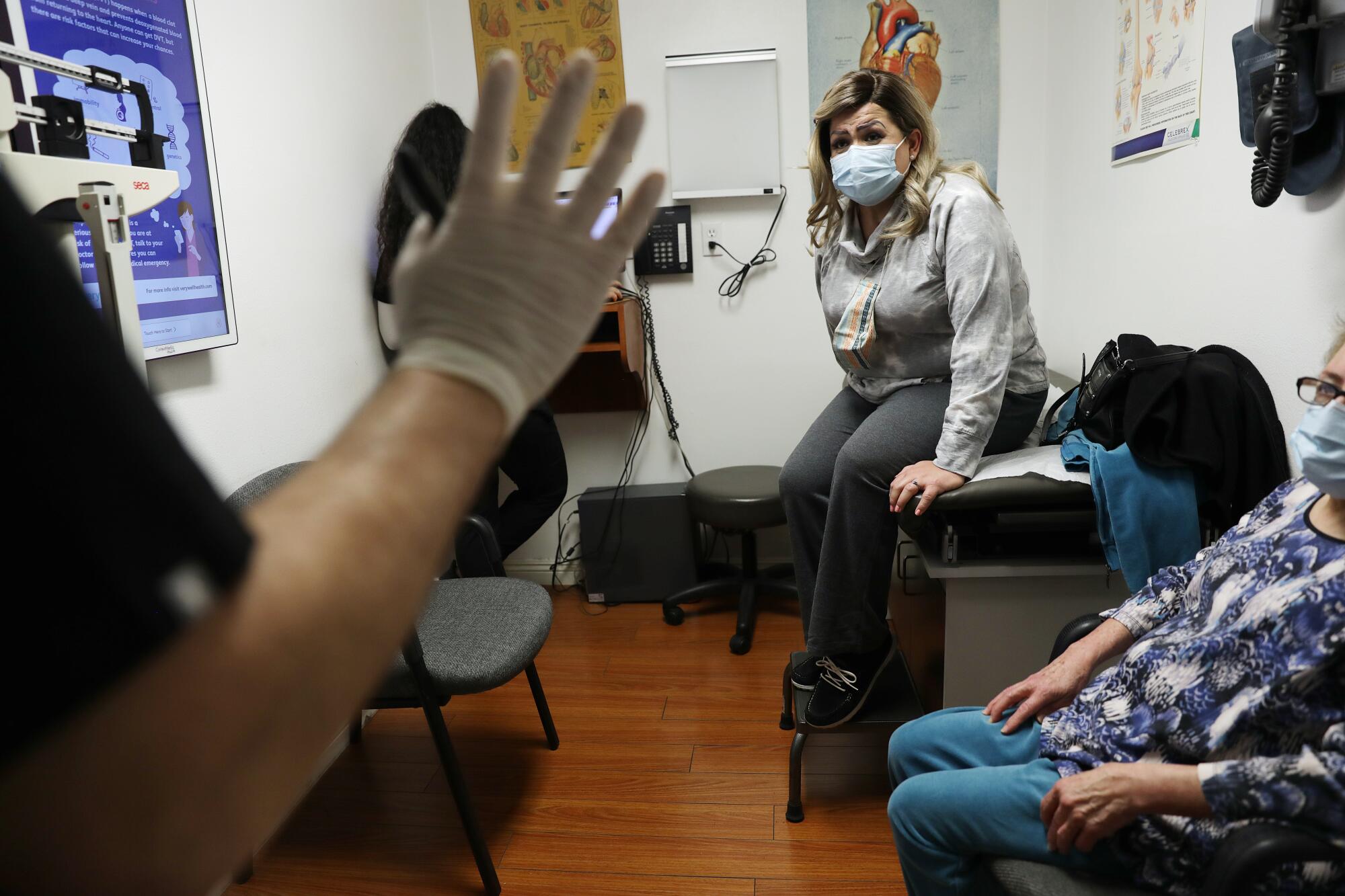
Ohanjanian had witnessed this before with COVID-19 patients. Lopez had been on blood thinners, but the coronavirus increases the viscosity of the blood. A clot could have cut off oxygen to her brain.
He tried to reassure her.
::
Criztiaan was grateful that his mother was getting well. He wanted to thank everyone who had risked their lives to save hers. He texted Levenstein, the social worker at the UCLA medical center.
I spent months being depressed and having countless mental breakdowns because I was afraid of my mom passing away, but you all put an end to that and I just thought it would be good to let you know that not only are you saving lives every day but you are bringing unimaginable amounts of joy to families who have been through lots of emotional pain.
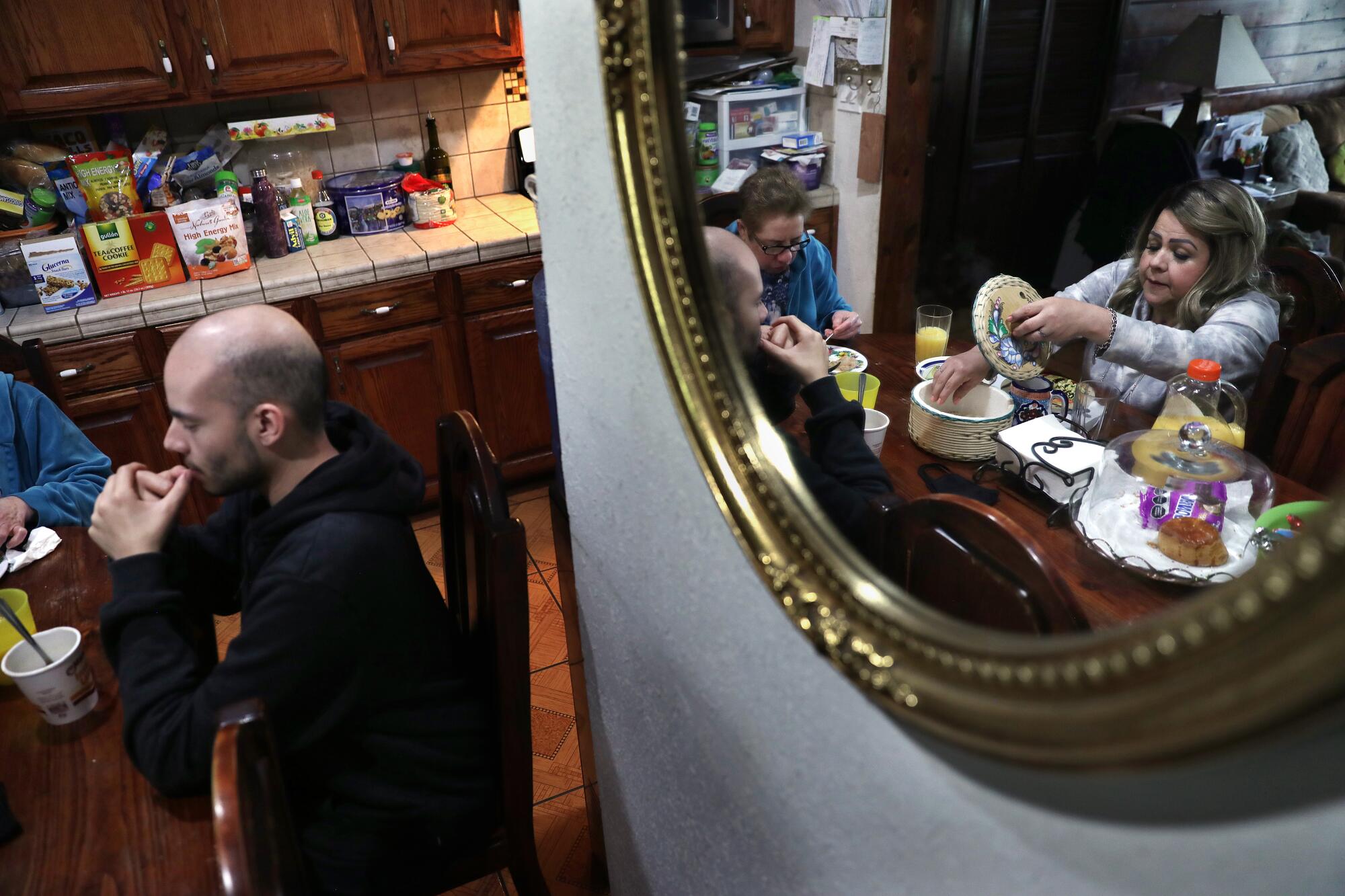
When he visited Lopez at Glendale Adventist, he saw that she had lost a lot of weight. He sat beside her. Holding her hand, he tried not to cry. He believed showing emotions made him weak, and he still had to hold up his family.
Yet his eyes were watering.
On Nov. 12, Blanca Lopez went home. Her father drove, and Lopez settled into the passenger seat and held on to a portable oxygen tank. Her rehabilitation was complete. The stroke was minor.
She had spent 14 weeks in two hospitals and 51 days on a machine few people had ever heard about, for an intervention that could cost more than $1.1 million. With so many people dying of this disease, she wondered why she was so lucky.
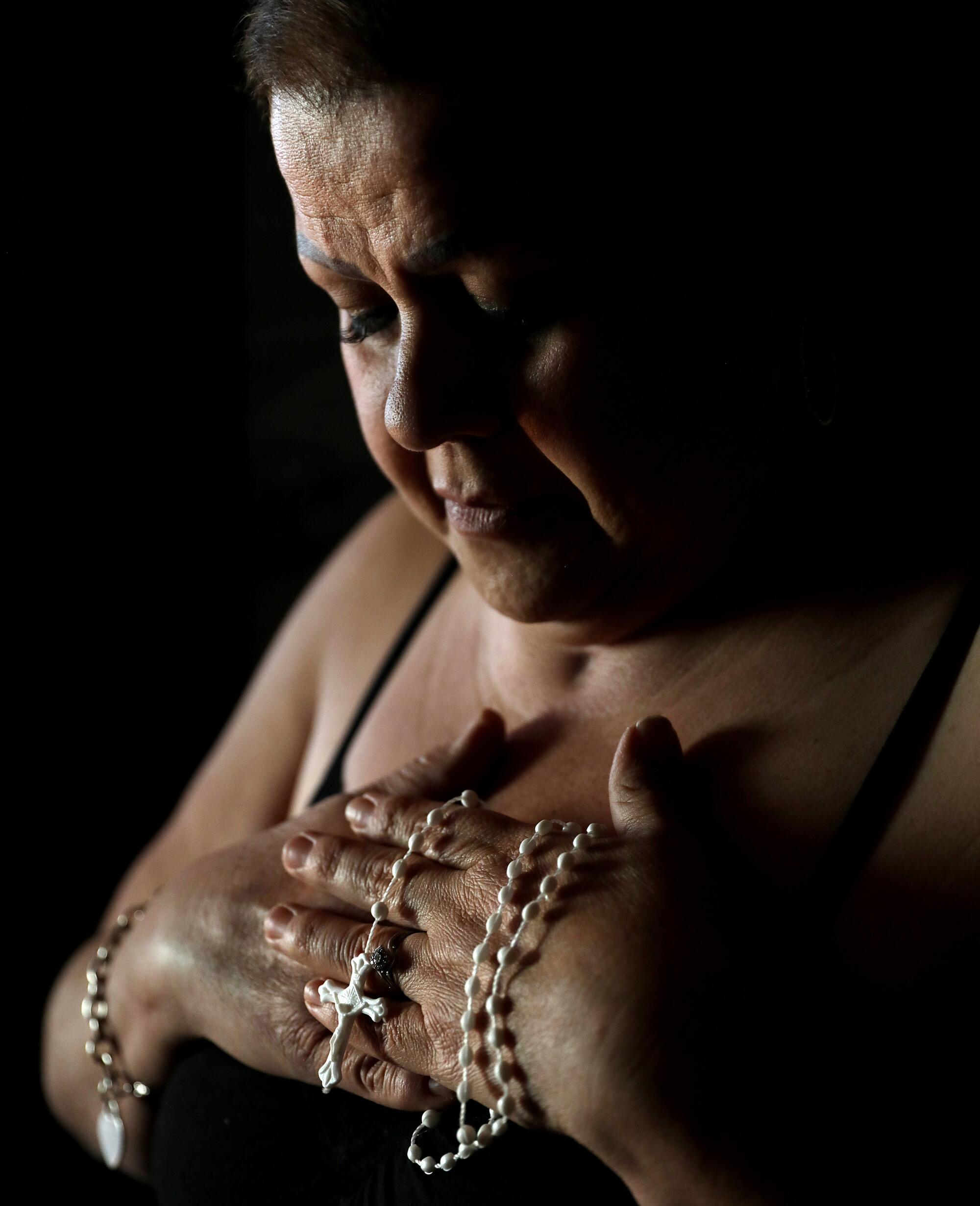
The sun was setting, and the outside air felt cool and fresh. She said she wanted a Big Mac, fries and a Dr Pepper.
No one said no.
As soon as she didnât need oxygen and could stand at a stove, she said, sheâd make the childrenâs favorite meal, mojo de ajo with shrimp and king crab legs, rice, yellow peppers and homemade sopas.
No more doughnuts for Grandpa.
A week later, she went through the small bag she had taken to the hospital so long ago. In the bottom, tangled with a bracelet, a gold chain, earrings and two rings, she found the white rosary.
Behind the story
ECMO patient Blanca Lopez survived 51 days in the ICU. She finally got the chance to thank her medical team in person.
The path to developing ECMO included stops at a Boston animal shelter and a Santa Barbara hospital.
More to Read
Sign up for Essential California
The most important California stories and recommendations in your inbox every morning.
You may occasionally receive promotional content from the Los Angeles Times.


